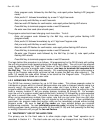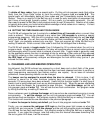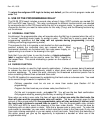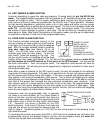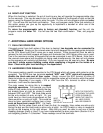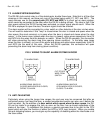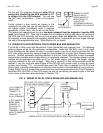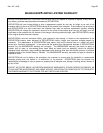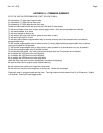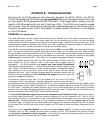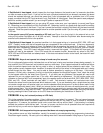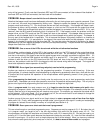Rev. A.2, 10/03 Page-iii
If PolySwitch #1 has tripped, visually inspect the four large diodes on the board to see if a loose wire has fallen
on them to create a short circuit. If you do not find such a physical problem that can be easily corrected, the board
should be replaced although you should be aware that it can be operated with no problems from a DC power
supply connected into the DC input terminals if only PolySwitch #1 has tripped. Read the special case paragraph
below for another possible cause if you are using AC power to operate a DC lock.
If PolySwitch #2 has tripped, and you are using DC power, make sure your input polarity is correct (see Figure
2). Reversing your input polarity will trip PolySwitch #2. Otherwise, look for any loose wires that could be creating
a short circuit anywhere on the board. If you can’t correct the fault that is tripping PolySwitch #2, the board must be
replaced. Read the special case paragraph below for another possible cause if you are using AC power to operate
a DC lock.
In the special case of AC power operating a DC lock (see Figure 4), a short circuit in the external lock or lock
wiring will trip either PolySwitch #1 or #2 (but not both). Attempt to reset the PolySwitch after disconnecting the
external lock to determine if this is the problem.
If PolySwitch #3 has tripped, the overload condition is in the keypad wiring or in terminals SRC, REX, UCD and
HCD. Carefully make sure that all keypad wires are connected to the correct terminals. If they are, temporarily
disconnect the keypad and attempt to reset PolySwitch #3 by de-powering the board for 5 seconds. Once the
board has been re-powered, momentarily connect SRC to REX to see if the board will function (the lock control
relay will operate). If the CPU board resumes function, reconnect the keypad. If PolySwitch #3 trips again, the
keypad will need to be replaced. If the CPU board did not resume function, disconnect any wires on the SRC,
REX, UCD and HCD terminals and attempt reset. If this does not restore function to the board, the board will need
to be replaced.
PROBLEM-- Keys do not operate but a beep is heard every five seconds
This is a diagnostic feature which indicates that one of the keys is being read as down (always being pressed). In
that condition, the CPU board will not be able to read any other keys. It can happen because of mechanical failure
within the switch element such that the key really is down, or keypad wires that are shorted to each other. The
latter problem usually happens when insulation is scraped off some of the wires in the keypad cable as it’s being
pulled through the door frame. You may be able to restore operation by rapping on all the keys. If this works,
however, it is likely only a temporary fix and you should be prepared to change the keypad. Next, check the wiring
of the keypad cable into the board (see Figure 2). If you don’t see any problems, the keypad will need to be
replaced but you can restore partial use, if you wish, while awaiting a replacement. Put the positive probe of a
voltmeter on terminal WHT and successively apply the negative probe on terminals BLK, GRY, BRN, BGE, ORG,
PNK, and VIO. “Good” terminals will read about 11 volts. Two terminals, however, will read about zero volts.
Remove the wires from the two terminals which read zero volts. If you are wondering why a single down key does
not create a single zero volt terminal read, you should understand that the keys are in a two of seven matrix so the
one to one relationship doesn’t hold. When you remove the two wires from the zero volt reading terminals, you will
disable several keys. You will be able to determine which keys are working by pressing each key and seeing which
ones are echoed by a beep and LED flash. You can then establish a temporary Hard code using only the active
keys by pressing the Hard Code button on the CPU board and following the instructions in Section 4.1.
PROBLEM-- A key isn’t echoed (no beep or LED flash)
This is the opposite of the above problem. A key is failing to be read when it is pressed. This can happen because
of mechanical failure within the switch element such that the key will not close, or from a broken or mis-wired
keypad wire. If, however, the problem is with a wire, more than one key will be “dead”. If just one key is not being
echoed, the problem is with the key itself. You can, of course, use the unit for all operations that don’t require that
particular key but you will want to replace the keypad for full operation.
PROBLEM-- Unit beeps when keys are pressed but does not accept programming
If the problem occurs on initial installation, usually it's caused by misunderstanding the programming instructions.
Read them again carefully. Be sure you're not waiting more than 5 seconds between hitting keys as if you are, the





